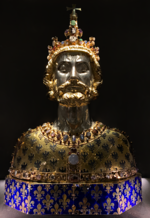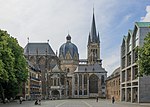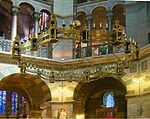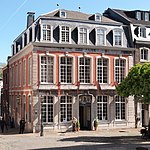Palatine Chapel, Aachen
9th-century churches in Germany9th-century establishments in GermanyBuildings and structures in AachenCarolingian architectureChurch buildings with domes ... and 4 more
Octagonal churchesReligious buildings and structures completed in 805Roman Catholic chapels in GermanyRoman Catholic churches in North Rhine-Westphalia

The Palatine Chapel in Aachen is an early medieval chapel and remaining component of Charlemagne's Palace of Aachen in what is now Germany. Although the palace itself no longer exists, the chapel was preserved and now forms the central part of Aachen Cathedral. It is Aachen's major landmark and a central monument of the Carolingian Renaissance. The chapel held the remains of Charlemagne. Later it was appropriated by the Ottonians and coronations were held there from 936 to 1531.As part of Aachen Cathedral, the chapel is designated as a UNESCO World Heritage Site.
Excerpt from the Wikipedia article Palatine Chapel, Aachen (License: CC BY-SA 3.0, Authors, Images).Palatine Chapel, Aachen
Domhof, Aachen Burtscheid (Aachen-Mitte)
Geographical coordinates (GPS) Address Phone number Website Nearby Places Show on map
Geographical coordinates (GPS)
| Latitude | Longitude |
|---|---|
| N 50.7747 ° | E 6.08444 ° |
Address
Aachener Dom
Domhof 1
52062 Aachen, Burtscheid (Aachen-Mitte)
North Rhine-Westphalia, Germany
Open on Google Maps










